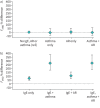Contributions of asthma, rhinitis and IgE to exhaled nitric oxide in adolescents
- PMID: 33898613
- PMCID: PMC8053905
- DOI: 10.1183/23120541.00945-2020
Contributions of asthma, rhinitis and IgE to exhaled nitric oxide in adolescents
Abstract
Exhaled nitric oxide fraction (F eNO) is an indicator of allergic airway inflammation. However, it is unknown how asthma, allergic rhinitis (AR) and allergic sensitisation relate to F eNO, particularly among adolescents and in overlapping conditions. We sought to determine the associations between asthma, AR, and aeroallergen immunoglobulin (Ig)E and F eNO in adolescents. We measured F eNO among 929 adolescents (aged 11-16 years) in Project Viva, an unselected prebirth cohort in Massachusetts, USA. We defined asthma as ever asthma physician diagnosis plus wheezing in the past year or taking asthma medications in the past month, AR as a physician diagnosis of hay fever or AR, and aeroallergen IgE as any IgE >0.35 IU·mL-1 among 592 participants who provided blood samples. We examined associations of asthma, AR and IgE with percent difference in F eNO in linear regression models adjusted for sex, race/ethnicity, age and height, maternal education and smoking during pregnancy, and household/neighbourhood demographics. Asthma (14%) was associated with 97% higher F eNO (95% CI 70-128%), AR (21%) with 45% higher F eNO (95% CI 28-65%), and aeroallergen IgE (58%) with 102% higher F eNO (95% CI 80-126%) compared to those without each condition, respectively. In the absence of asthma or AR, aeroallergen IgE was associated with 75% higher F eNO (95% CI 52-101), while asthma and AR were not associated with F eNO in the absence of IgE. The link between asthma and AR with F eNO is limited to those with IgE-mediated phenotypes. F eNO may be elevated in those with allergic sensitisation alone, even in the absence of asthma or AR.
Copyright ©The authors 2021.
Conflict of interest statement
Conflict of interest: B.M. Flashner has nothing to disclose. Conflict of interest: S.L. Rifas-Shiman reports grants from the US National Institutes of Health during the conduct of the study. Conflict of interest: E. Oken reports grants from the US National Institutes of Health during the conduct of the study. Conflict of interest: C.A. Camargo Jr has nothing to disclose. Conflict of interest: T.A.E. Platts-Mills has nothing to disclose. Conflict of interest: L. Workman has nothing to disclose. Conflict of interest: A.A. Litonjua has nothing to disclose. Conflict of interest: D.R. Gold reports grants from the US National Institutes of Health during the conduct of the study. Conflict of interest: M.B. Rice reports grants from the US National Institutes of Health during the conduct of the study.
Figures
Similar articles
-
Exhaled nitric oxide is associated with allergic inflammation in children.J Korean Med Sci. 2011 Oct;26(10):1265-9. doi: 10.3346/jkms.2011.26.10.1265. Epub 2011 Oct 1. J Korean Med Sci. 2011. PMID: 22022176 Free PMC article.
-
Exhaled nitric oxide, total serum IgE and allergic sensitization in childhood asthma and allergic rhinitis.Pediatr Allergy Immunol. 2005 May;16(3):236-42. doi: 10.1111/j.1399-3038.2005.00265.x. Pediatr Allergy Immunol. 2005. PMID: 15853953
-
Comparison of exhaled nitric oxide levels in pediatric patients with allergic rhinitis.Int J Pediatr Otorhinolaryngol. 2019 Nov;126:109603. doi: 10.1016/j.ijporl.2019.109603. Epub 2019 Jul 26. Int J Pediatr Otorhinolaryngol. 2019. PMID: 31369971
-
Clinical utility of exhaled nitric oxide fraction in the management of asthma and COPD.Breathe (Sheff). 2019 Dec;15(4):306-316. doi: 10.1183/20734735.0268-2019. Breathe (Sheff). 2019. PMID: 31803265 Free PMC article. Review.
-
Aeroallergen sensitization in asthma: prevalence and correlation with severity.Allergy Asthma Proc. 2010 Mar-Apr;31(2):96-102. doi: 10.2500/aap.2010.31.3310. Allergy Asthma Proc. 2010. PMID: 20406591 Review.
Cited by
-
Associations of Infant Colic and Excessive Crying With Atopic Outcomes in Childhood and Adolescence.J Pediatr. 2025 Aug;283:114623. doi: 10.1016/j.jpeds.2025.114623. Epub 2025 Apr 23. J Pediatr. 2025. PMID: 40280470
-
Clinical Applications of Nasal Nitric Oxide in Allergic Rhinitis: A Review of the Literature.J Clin Med. 2023 Aug 2;12(15):5081. doi: 10.3390/jcm12155081. J Clin Med. 2023. PMID: 37568482 Free PMC article. Review.
-
Short-term exposure to relative humidity and lung health in early adolescents.Environ Epidemiol. 2025 Feb 10;9(2):e371. doi: 10.1097/EE9.0000000000000371. eCollection 2025 Apr. Environ Epidemiol. 2025. PMID: 39957761 Free PMC article.
-
Precision Medicine and Childhood Asthma: A Guide for the Unwary.J Pers Med. 2022 Jan 10;12(1):82. doi: 10.3390/jpm12010082. J Pers Med. 2022. PMID: 35055397 Free PMC article. Review.
-
Precipitation and Adolescent Respiratory Health in the Northeast United States.Ann Am Thorac Soc. 2023 May;20(5):698-704. doi: 10.1513/AnnalsATS.202209-805OC. Ann Am Thorac Soc. 2023. PMID: 36749585 Free PMC article.
References
Grants and funding
LinkOut - more resources
Full Text Sources
Other Literature Sources
Research Materials
Miscellaneous

